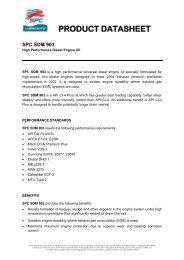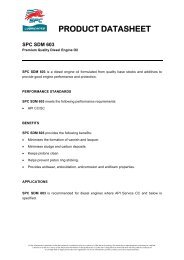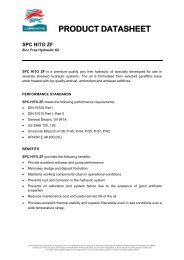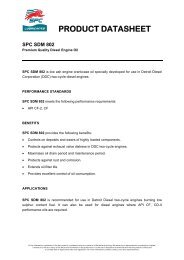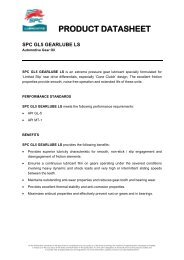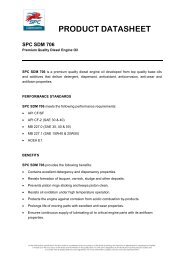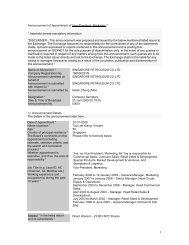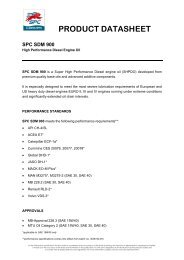Refining, Supply & Trading - SPC
Refining, Supply & Trading - SPC
Refining, Supply & Trading - SPC
You also want an ePaper? Increase the reach of your titles
YUMPU automatically turns print PDFs into web optimized ePapers that Google loves.
<strong>Refining</strong>, <strong>Supply</strong> & <strong>Trading</strong><br />
The <strong>Refining</strong>, <strong>Supply</strong> and <strong>Trading</strong> BU’s primary role is<br />
to ensure the proper, safe and optimum performance<br />
of the Group’s refining facility, SRC on Jurong Island.<br />
The BU is also involved in the sourcing of crudes and<br />
feedstocks for the refinery, the sales of jet fuel to airline<br />
customers, sales and trading of residue and distillate<br />
refined products, oil price risk management and the<br />
operations of the Group’s storage and terminalling facility.<br />
Refinery Performance<br />
Global crude and refining capacity additions had continued<br />
to lag behind the robust growth in demand for refined<br />
products in the last few years. Global petroleum product<br />
demand was estimated to be 83.7 million barrels<br />
per day (bpd) in 2005 with the highest demand of<br />
85.6 million bpd recorded in the fourth quarter. The<br />
shortage of refining capacity had been identified as the<br />
key bottleneck in satisfying the world’s growing demand<br />
for refined products.<br />
The Asia Pacific region had continued to witness demand<br />
growth above the global average despite the withdrawal<br />
of fuel subsidies in certain countries. China and India<br />
registered impressive economic growth of more than<br />
nine and seven percent respectively. With the steady<br />
recoveries in Japan and Korea and the Southeast Asian<br />
economies, the region’s appetite for petroleum products<br />
to fuel economic growth had continued unabated.<br />
In 2005, geopolitical tensions in the Middle East and<br />
fears of interruptions to the supply of both crudes and<br />
refined products provided strong support for oil prices<br />
and refining margins. The Asia Pacific product prices<br />
continued to be heavily influenced by demand spikes in<br />
the US, as well as events in the Middle East. Historically,<br />
demand spikes in the US had mostly been the result of<br />
weather patterns and the summer driving season. In<br />
2005, however, the hurricanes that battered the US Gulf<br />
Coast caused oil prices and refining margins to spike up<br />
sharply in the third quarter. The benchmark WTI crude<br />
surged to a record US$70.85 per barrel in August.<br />
In tandem with the surge in crude prices, gasoline and<br />
distillate fuel prices also rose to a record high relative to<br />
the underlying crude prices. Regional refining margins<br />
peaked above US$11.00 per barrel in early September<br />
when it became clear that several refineries in the US<br />
Gulf Coast would be shutdown for several months as a<br />
result of the hurricanes.<br />
35
Left : The residue catalytic cracker complex at SRC. Right : <strong>SPC</strong> refuelling the Airbus A380 maiden test flight at Singapore Changi Airport.<br />
36<br />
Against the backdrop of the structural tight balance<br />
between supply and demand, geopolitical events and<br />
the US Gulf Coast hurricanes, <strong>SPC</strong> was able to record<br />
another remarkable year in refining performance and<br />
profitability. The Group realised refining margins above<br />
US$4.00 per barrel for 2005.<br />
The additional refining capacity coupled with the robust<br />
demand enabled the Group to process more than<br />
50 million barrels of crude and feedstocks through the<br />
refinery. Refinery utilisation was maximised at close to<br />
the nameplate capacity of 285,000 bpd. This was achieved<br />
by optimising the runs in the upgrading units as well. The<br />
average crude throughput achieved was 276,000 bpd,<br />
about 6.2 percent higher than in 2004. Due to the<br />
complexity and sophistication of the refining assets, <strong>SPC</strong><br />
was able to capitalise on the widening sweet-sour crude<br />
differentials to process heavier sour crudes to increase<br />
the margin spreads.<br />
To be able to capture margins at the opportune time, the<br />
refining assets need to be run reliably and safely. SRC<br />
had in the past year maintained an enviable reliability and<br />
safety record. As of December 2005, SRC had achieved<br />
a significant milestone of working close to six million<br />
manhours without lost time injury. At <strong>SPC</strong>, ensuring<br />
a safe and secure working environment across all its<br />
facilities will continue to be a core value driver.<br />
Going forward with regard to the refining assets, <strong>SPC</strong><br />
and SRC are focused on a clean fuels upgrading<br />
programme that will deliver further value creation and<br />
enhancement. This project which is currently undergoing<br />
management review would entail upgrading the SRC<br />
secondary processing facilities to meet Euro IV clean<br />
fuel specifications for motor gasoline with lower benzene<br />
and sulphur levels and Ultra-Low Sulphur Diesel (ULSD)<br />
production. When the clean fuels project is implemented,<br />
the Group would then be able to move up the value chain<br />
and meet the tighter product specifications in the region,<br />
when these are introduced.<br />
Aviation Sales<br />
<strong>SPC</strong> has more than 30 years of aviation sales marketing<br />
experience and has established a reputation as a reliable<br />
supplier of aviation fuel in the Asia Pacific region. The<br />
Aviation Sales unit markets and supplies aviation fuel to<br />
airlines at four international airports, namely in Singapore,<br />
Bangkok, Hong Kong and Taipei.<br />
The air transportation sector in Singapore grew strongly<br />
in 2005. Passenger arrival at Singapore Changi Airport<br />
reached a record 32 million passengers, an increase of<br />
6.8 percent over 2004. Air cargo grew to 1.8 million<br />
tonnes, a 3.3 percent increase over 2004. Four new<br />
airlines commenced operations at Singapore Changi<br />
Airport in 2005. As a result of the air traffic growth, the<br />
total jet fuel volume throughput at Singapore Changi<br />
Airport grew to 80,600 bpd. This was 6.2 percent higher<br />
compared to 2004.<br />
The unit’s activities are concentrated mainly at Singapore<br />
Changi Airport where it provides aviation refuelling<br />
services to 27 major airline companies. Jet fuel volume<br />
lifting for 2005 was 15,500 bpd, a 4.8 percent increase<br />
over 2004 for the Company. Singapore made history<br />
when it became the first airport in Asia to receive the<br />
Airbus A380 carrier. The largest commercial carrier on<br />
its maiden test flight landed at Singapore Changi Airport<br />
on 11 November 2005. <strong>SPC</strong> and another jet refueller<br />
jointly refuelled the aircraft before its departure for other<br />
Asian airports.
Amid stiff competition at Taipei’s Chiang Kai Shek<br />
International Airport, <strong>SPC</strong> managed to maintain its jet<br />
fuel volume of 1,600 bpd. This represents about<br />
16.9 percent of the jet fuel market.<br />
At Hong Kong International Airport, <strong>SPC</strong> achieved a jet<br />
fuel volume of 3,500 bpd. Air traffic continues to grow<br />
strongly at Hong Kong International Airport due to increase<br />
in air passengers and air cargo demand. Currently, <strong>SPC</strong><br />
services four airlines at this location and higher fuel lifting<br />
by its air cargo customers enabled <strong>SPC</strong> to register a<br />
modest three percent growth in volume in 2005 over<br />
the previous year.<br />
In its second year of operation at Bangkok International<br />
Airport, <strong>SPC</strong> continued to strengthen its ground<br />
co-ordination and logistics set-up to enhance its<br />
into-plane refuelling services. <strong>SPC</strong> achieved a slightly<br />
higher market share in this highly competitive market<br />
and presently services five airlines at this location.<br />
2006 will be another challenging year for the aviation<br />
industry as major carriers continue to streamline their<br />
operations through efficiency gains, cost-saving measures<br />
and consolidation in order to cope with high fuel prices.<br />
Distillates<br />
The Distillates unit is responsible for the sale and trading<br />
of distillate products. Distillate products represent the<br />
lighter end of the refining process and include chemical<br />
naphtha, motor gasoline, jet fuel and gas oil. Besides<br />
trading the products from SRC, the Distillate unit also<br />
sourced such products from third parties including other<br />
refineries and oil traders.<br />
With the Group’s increased refining capacity since<br />
mid-2004, the volume of distillate products available to<br />
the unit had increased. The Distillate unit was also able<br />
to capitalise on trading opportunities and hence registered<br />
an increase in trading volume. The unit was thus able<br />
to capture a larger share of the demand for distillate<br />
products. Demand for distillates reached historic highs<br />
during the third quarter of 2005 due to the hurricanes<br />
in the US Gulf Coast.<br />
Despite the robust global demand for refined products,<br />
distillate trading remained a challenging activity given<br />
the continued price volatility. The unit had to trade and<br />
compete aggressively to capture profitable sales. In 2005,<br />
the Distillate unit achieved a turnover volume of 35 million<br />
barrels, a growth of 35 percent over the previous year.<br />
To sustain the unit’s performance, continued emphasis<br />
will be placed on prudent management of inventories.<br />
Traders in the unit monitor the market closely to capture<br />
opportunities whenever they arise.<br />
The tight global refining capacity is expected to persist<br />
over the next two to three years. Growth momentum in<br />
the demand for distillate products is likely to be maintained<br />
as well. The expected growth in air travel would also<br />
result in higher consumption of jet fuel and will provide<br />
opportunities for the unit to increase its jet fuel trading.<br />
The unit will therefore continue to play a key role in the<br />
Company’s downstream activities and profitability in 2006.<br />
Residue<br />
<strong>SPC</strong> has been in the bunkering business since 1972 and<br />
is a leading and reliable supplier in Singapore. The Residue<br />
unit handles the sale of bunker fuels and the trading of<br />
fuel oil for the Group.<br />
Singapore has maintained its status as one of the world’s<br />
top bunkering port with more than 3,200 ships registered<br />
under the Singapore flag. The maritime sector in Singapore<br />
achieved an excellent growth rate in 2005. Singapore<br />
set new records for shipping tonnage, container and<br />
cargo throughput and bunker sales. For the second time<br />
in Singapore's maritime history, total vessel arrivals in<br />
terms of shipping tonnage crossed the one billion mark<br />
with 1.2 billion gross tonnes (GT) in 2005, outstripping<br />
2004's 1.04 billion GT. Container traffic increased by<br />
8.7 percent to 23.2 million twenty-foot equivalent units<br />
(TEUs) in 2005 from 21.3 million in 2004, setting a new<br />
record for the Singapore port. A healthy growth rate<br />
of 7.6 percent was also recorded for cargo throughput<br />
which topped 423 million tonnes in 2005. Given the<br />
growth in shipping tonnage, sales of bunker fuels crossed<br />
25 million tonnes in 2005, surpassing the 2004’s record<br />
of 23.6 million tonnes.<br />
Average fuel oil prices had risen almost 60 percent<br />
in 2005 as compared to 2004. Fears of supply<br />
disruption brought about by the hurricanes in end August<br />
hiked fuel prices to record highs, affecting demand<br />
especially from China. 2005 also witnessed irregular<br />
import volumes into Singapore due to volatile prices and<br />
freight costs. In the face of these uncertainties, the unit<br />
adopted a cautious approach especially in its fuel oil<br />
trading activities.<br />
A higher growth rate in the maritime sector in Singapore<br />
provided sustained business opportunities for the Residue<br />
unit in 2005. However, sustained high prices and demandsupply<br />
imbalances continued to challenge the marine<br />
fuel traders and suppliers. The Residue unit was able to<br />
effectively manage these challenges to meet its delivery<br />
commitments during the year.<br />
In May 2005, the International Maritime Organisation<br />
mandated higher quality standards for marine fuels. The<br />
unit worked closely with SRC to ensure that its fuel oil<br />
products met the quality standards of MARPOL (Marine<br />
Pollution) 73/78 Annex VI.<br />
37
Left : <strong>SPC</strong> has been in the bunkering business since 1972 and is a leading and reliable supplier in Singapore.<br />
Right : VLCC (Very Large Crude Carrier) discharging crude oil at TMS’s (Tanker Mooring Services Company Pte Ltd) fixed jetty for SRC at Jurong Island.<br />
<strong>SPC</strong> also successfully renewed its QMBS (Quality<br />
Management for Bunker <strong>Supply</strong> Chain) and remained as<br />
an accredited bunker supplier under the Maritime Port<br />
Authority Accreditation Scheme.<br />
For 2006, with more environmental pressure for<br />
improved product specifications, higher operational<br />
costs relating to higher utilisation of double-hulled barges<br />
are expected. The unit will continue to leverage on its<br />
strengths and resources to effectively manage barges<br />
turnaround, inventory, quality and other operational and<br />
logistic matters.<br />
Operations and Logistics<br />
The Company owns a storage terminal at Pulau Sebarok<br />
for storage of petroleum products to support its marine<br />
bunker, products trading and marketing activities. The<br />
offshore 220,000-cubic metre storage terminal with<br />
13 storage tanks is equipped with a deepwater jetty for<br />
tankers up to 160,000-tonne displacement. It also has<br />
a smaller jetty for barges up to 10,000-tonne displacement.<br />
The terminal is equipped with a comprehensive laboratory<br />
and is highly automated to provide a quick turnaround<br />
for tanker and barge operations.<br />
In 2005, the terminal handled a product throughput<br />
of 2.8 million tonnes.<br />
Risk Management and Derivatives<br />
The Risk Management and Derivatives unit is responsible<br />
for the management of the Company’s oil inventory and<br />
refining margin price risks.<br />
The unit applies a Value-at-Risk (VAR) methodology to<br />
identify the Group’s risk parameters and risks appetite.<br />
In 2005, the unit hedged against volatile price risks for<br />
its crude oil inventory and the refined products by entering<br />
into crude oil and refined products swaps and options<br />
contracts. These contracts are executed through the<br />
OTC (over the counter) market. These transactions are<br />
normally of a short term tenor ranging from three to<br />
12 months.<br />
A rigorous process is undertaken to ensure that<br />
counterparties’ risks are evaluated and constantly updated.<br />
Regular meetings are conducted to monitor and review<br />
the Group’s crude oil and product risks and price exposures<br />
and to ensure that these risks are well managed.<br />
Through active management of the Company’s positions,<br />
the unit managed to contain the Group’s exposure to the<br />
extreme volatilities in the market to acceptable levels.<br />
In 2005, the unit implemented a <strong>Trading</strong> and Risk<br />
Management System (TRMS). This system enables the<br />
automated recording and capture of both physical and<br />
paper transactions. It also provides an instantaneous<br />
helicopter view of the Group’s consolidated positions<br />
in both the physical as well as the derivatives market.<br />
More critically, the system provides an automated and<br />
updated Mark-to-Market positions for decision making.<br />
The trading environment is expected to be challenging<br />
in 2006. The unit will continue to proactively fine tune<br />
its hedging strategies and further enhance the TRMS to<br />
better manage the Company’s oil inventory and refining<br />
margin price risks.<br />
38




